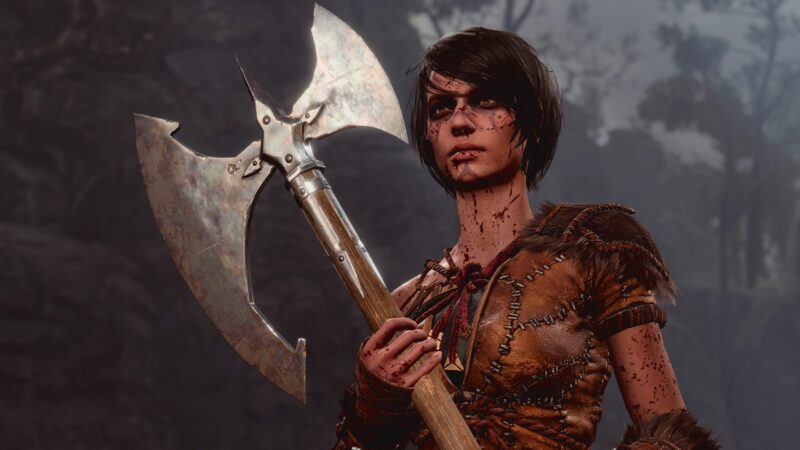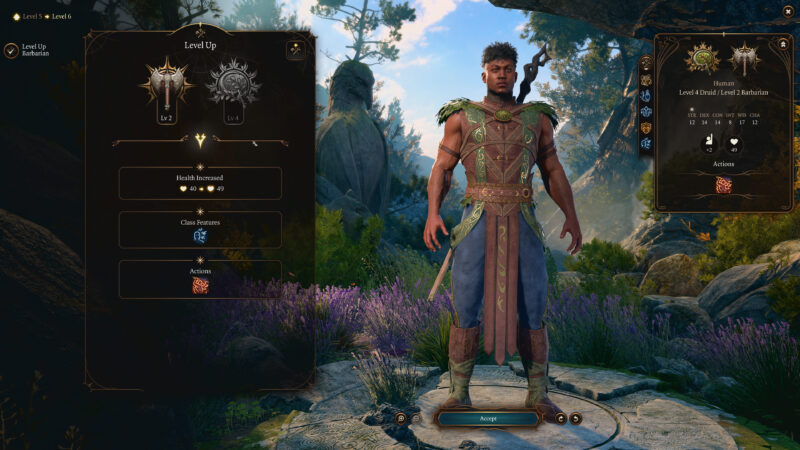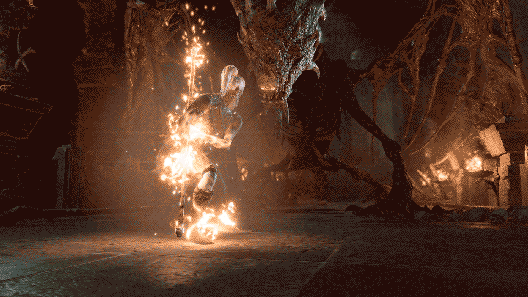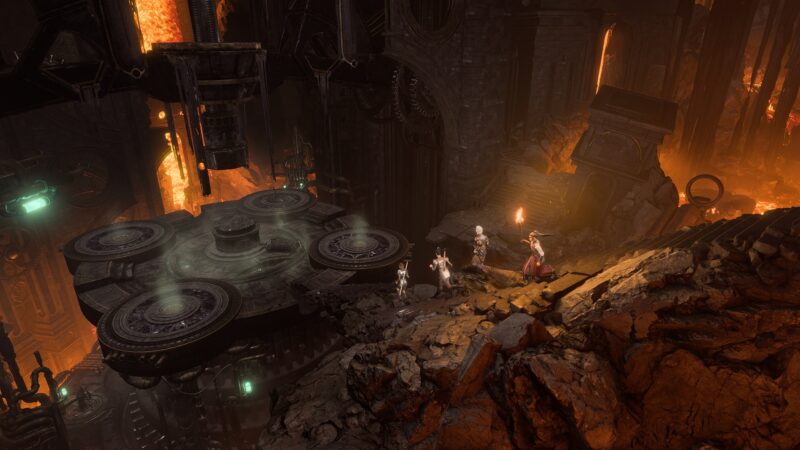The multiclassing is a core part of Dungeons and Dragons, but how will it work in Baldur’s Gate 3? There are 12 base classes!

Multiclassing in Baldur’s Gate 3 is at a certain level, adding extra class benefits or classes to your primary class. In short, this allows you to create a character that has more than one class and can use spells, attacks, or even dialogue options from all of them.
Baldur’s Gate 3 Multiclassing
In the fifth edition of Dungeon and Dragons tabletop game’s rules to create the perfect and the best character, players sometimes can choose other classes’ advantages. Will the BG3 video game have the same freedom? Yes! In Baldur’s Gate 3 final version, players can multiclassing and personalize their protagonist even further.
On Reddit, one of Larian Studios’ lead developers hosted an event for fans. One of the users asked: “How will multiclassing work?”
Multiclassing rule will follow closely the 5e DnD. On level up characters will be able to continue with their current class or choose a new class, provided they meet the requirements.
Swen Vincke, Larian Studios, The Creative Director
How Does Multiclassing Work?

Multiclassing in Baldur’s Gate 3 allows players to expand and further customize their characters with more than one class. While it brings certain benefits because you can combine the strengths of one class with another, it also has limitations and downsides. The level cap in BG3 is 12, so you can’t take more levels than that. As a result, if you take a certain amount of levels into one class and a few into different ones, you have bonuses that each class receives at that level, not your overall character level.
For example, if you are a level 4 and multiclassing into Druid and Fighter 2/2, it means you get all bonuses from the fighter on levels 1 and 2, including action surge – which is a fantastic action that gives you an extra attack. Plus bonuses from the druid class on levels 1 and 2, which are spells level 1 and four weakest wild shape forms, but your character overall is at level 4. Meanwhile, if you spend all those 4 levels in a druid class, you would get access to level 2 spells and additional, stronger wild shape forms at level 4, so you miss a lot of good druid advantages when multiclassing it, especially early in the game. However, you gain something in return, too.
So always, whenever you decide to multiclass your character, ensure you won’t lose any important spells, spell levels, or special class features on actions. Also, decide what will give your character more power. Is losing one thing worth investing in another? Lastly, it’s your character, and you can multiclass it into whatever fits your story, background, or roleplaying. Below, we are going to give you some inside, which hopefully will help you build your protagonist unique and just as you desire them to be.
How to Multiclass?
To multiclass your character, click the small “plus with crossed tools” icon in the top left corner of the level-up screen menu and pick a new class.
You can switch to another class and its advantages or spells at any time you desire. In the game, a special NPC will help players explain the process of resetting to another desired class. Also, you’ll be able to spend all your levels again and start a completely new class or multiclass without starting a new game and coming back to the character creation menu. Those features open testing different combinations as you follow the story and advance your levels.
You don’t need to meet any requirements to forge a Class With Multiclassing. However, some classes will pair better than others because their damage or class abilities are based on the same attribute. For Example, Warlock, Sorcerer, and Bard are all charisma-based classes, so it’ll be a perfect match to pick skills from one and enhance them further with the capabilities of another. Additionally, if you decide to multiclass, you can select dialogue options from all picked classes.
A good example would be a Bard class that has great support capabilities and roleplaying aspects. However, it’s lacking the damage spells and cantrips. At level 4, you could choose the Warlock class to gain an extra Hex spell and Eldritch Blast, a combo that deals fantastic damage and can maximize your combat capabilities. You’ll be picking the best qualities each class offers.
Important Multiclassing Features
Here is a list of the most important multiclassing features in Baldur’s Gate 3:
- Ability Scores won’t limit multiclassing in Baldur’s Gate 3
- Your character will receive all new class features at that level.
- You won’t get new Saving Throw Proficiencies
- Not all Weapon and Armor Proficiencies of the new class will become available when multiclassing.
- Only the Rogue, Ranger, and Bard classes receive extra Skill Proficiency.
Below is a list of Multiclass Proficiencies gained by taking one level in a new class:
| Class | Gained Proficiency |
|---|---|
| Barbarian | Shields, Simple Weapons, Martial Weapons |
| Bard | Light Armor, One skill, One instrument |
| Cleric | Light Armor, Medium Armor, Shields, Morningstars |
| Druid | Light Armor, Medium Armor, Shields |
| Fighter | Light Armor, Medium Armor, Shields, Simple Weapons, Martial Weapons |
| Monk | Simple Weapons, Shortswords |
| Paladin | Light Armor, Medium Armor, Shields, Simple Weapons, Martial Weapons |
| Ranger | Light Armor, Medium Armor, Shields, Simple Weapons, Martial Weapons, One skill |
| Rogue | Light Armor, One skill |
| Sorcerer | – |
| Warlock | Light armor, Simple Weapons |
| Wizard | – |
Should you Multiclassing in Baldur’s Gate 3? – Multiclassing Benefits

While multiclassing may seem like an enticing option in Baldur’s Gate 3, you should recognize that it can sometimes lead to hazardous outcomes for your character’s build. Multiclassing can lead to a mismatch between your character’s existing Ability Scores, and those are extremely important and needed for the new class. For instance, becoming a Rogue with low Dexterity might seem tempting, but it’ll lower your damage and survivability and is not recommended. It can result in reduced attack accuracy and effectiveness.
Additionally, Multiclassing can delay important power boosts that characters typically gain at specific levels. These include Level 2 for Druids, access to Wild Shape, and its many forms. Level 3 new higher-level spells for spellcasters and subclasses choice for most classes. At Levels 4, 8, and 12 all classes receive Ability Score improvements and Feats.
While multiclassing can offer versatility, it’s crucial to consider the potential downsides like Ability Score mismatch and delayed power progression. Making informed decisions about multiclassing will help ensure your character remains effective and doesn’t fall behind.
Multiclassing in Baldur’s Gate 3 offers increased versatility and potential benefits, but it’s important to approach it with caution. The key lies in creating synergies between classes to enhance strengths and mitigate weaknesses. No doubt multiclassing can provide benefits to your build. After all, picking actions and spells, whatever you desire at each level, can be alluring.

Source: Larian Studios
Here are some of the most popular D&D 5e multiclassing ideas in Baldur’s Gate 3:
- Bard & Warlock: Both classes are Charisma-based classes, meaning they work well together since they share a spellcasting modifier.
- Barbarian & Druid: You can combine the benefits of rage and damage reduction with druids’ wild shape survivability and utility.
- Rogue & Ranger: As two dexterity-based classes, they can work together fantastically, dealing critical damage from melee and range.
- Sorcerer & Warlock: One of the most powerful combos, you take advantage of the most powerful cantrip, Eldritch Blast, and combine it with Sorcerer meta magic to create a robust spellcasting build.
The synergy between classes is crucial for a successful multiclass build, as it allows characters to leverage the strengths of each class and create a more versatile and effective character overall. However, multiclassing can also come with drawbacks that might impact your character’s progression and effectiveness. It’s important to weigh the benefits of increased versatility and unique abilities against the potential challenges and trade-offs that come with multiclassing.
For Baldur’s Gate 3 multiclassing, players must wait until the final release on August 3rd, 2023. Currently, there are 11 base classes in Baldur’s Gate 3.
Looking for more Baldur’s Gate 3?
Thank you for reading Baldur’s Gate 3 Multiclassing: How Does It Work? Article! We provide the latest news and create guides for the BG 3. Additionally, check out our website, watch me play games on Twitch, or visit my YouTube channel!

